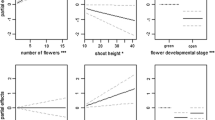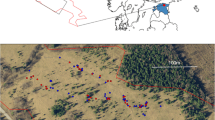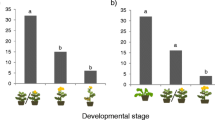Abstract
Female Larinus latus lay eggs into the capitula of their Onopordum spp. host plants from the onset of capitulum development until the completion of flowering. This tight linkage between insect life-history and plant development optimised larval survival, apart from some initial asynchrony between the readiness of the females to oviposit and the suitability of the very small capitula to physically support eggs. Eggs were laid on bracts and stems of capitula or directly in the florets, when these became available. Both the location of the egg and time of oviposition influenced mortality factors such as egg and larval parasitism, egg desiccation and larval establishment. Overall, survival of eggs laid later in the season into florets was higher, although the adults that emerged were smaller. The change in choice of oviposition site that occurs at the onset of flowering, not only favours survival, but ensures more efficient resource use by the larvae. This occurs because sequential flowering of Onopordum spp. drives a sequential oviposition pattern and spreads the egg load more evenly over the available capitula, reversing a trend earlier in the season to clump eggs that were laid directly on the bracts. Other potential constraints, such as capitulum size, absolute egg density and previous egg-laying do not play a major role in determining the oviposition pattern of L. latus. Larval survival was positively correlated with capitulum size and not strongly influenced by egg density. Competition for resources only appeared to play a role in smaller capitula, and manifested itself in a reduction in the size of emerging adults rather than the death of immatures. In the absence of strong interspecific competition, the oviposition behavior of L. latus has become geared to maximising resource use for larvae (i.e. its own potential competitiveness) rather than minimising interactions with other members of the capitulum endophage guild.
Similar content being viewed by others
References
Briese DT (1995) Population structure and regulation of the Onopordum capitulum weevil Larinus latus (Coleoptera: Curculionidae) Oecologia (in press)
Briese DT, Sheppard AW (1992) Biogeography, host-choice and speciation in two Mediterranean species of the weevil genus Larinus. In: Thanos CA (ed) Proceedings of the VI International Conference on Mediterranean-type Ecosystems. University of Athens, Athens, pp 307–314
Briese DT, Sheppard AW, Zwölfer H, Boldt PE (1994) The phytophagous insect fauna of Onopordum thistles in the northern Mediterranean basin. Biol J Linn Soc 53: 231–253
Krebs CJ (1989) Ecological methodology. Harper Collins, New York
Lalonde RG, Roitberg BD (1992) Host selection behavior of a thistle-feeding fly: choices and consequences. Oecologia 90: 534–539
Price PW (1988) Inversely density dependent parasitism: the role of plant refuges for hosts. J Anim Ecol 57: 89–96
Price PW (1993) Patterns in the population dynamics of insect herbivores. In: Leather SR (ed) Individuals, Populations and Patterns in Ecology. Intercept, Andover, pp 109–117
Redfern M, Cameron (1989) Density and survival of introduced populations of Urophora stylata (Diptera: Tephritidae) in Cirsium vulgare in Canada, compared with native populations. In: Delfosse ES (ed) Proceedings of the VII International Symposium on Biological Control of Weeds. MAF, Rome, pp 203–210
Römstöck-Völkl M (1990) Population dynamics of Tephritis conura Loew (Diptera: Tephritidae): determinants of density from three trophic levels. J Anim Ecol 59: 251–268
Römstöck-Völkl M, Wissel C (1989) Spatial and seasonal patterns in the egg distribution of Tephritis conura (Diptera: Tephritidae). Oikos 55: 165–174
Rivero-Lynch AP, Jones TH (1993) The choice of oviposition site by Terellia ruficauda on Cirsium palustre. Acta Oecol 14: 643–651
Sheppard AW, Briese DT, Michalakis Y (1995) Host choice in the field in the genus Larinus (Coleoptera: Curclionidae) attacking Onopordum and Cynara (Asteraceae). In: Scott RR, Delfosse ES (eds) Proceedings of the VIII International Symposium on Biological Control of Weeds. CSIRO, Melbourne, in press
Sheppard AW, Michalakis Y, Briese DT, Thomann T (1992) Spatial scale in the interaction between seed-head weevils and their host plants (Asteraceae: Cardueae) in a Mediterranean sheep-grazing system. In: Thanos CA (ed) Proceedings of the VI International Conference on Mediterranean-type Ecosystems. University of Athens, Athens, pp 183–190
Straw NA (1989a) Taxonomy, attack strategies and host relations in flowerhead Tephritidae: a review. Ecol Entomol 14: 455–462
Straw NA (1989b) The timing of oviposition and larval growth by two tephritid fly species in relation to host-plant development. Ecol Entomol 14: 443–454
Straw NA (1989c) Evidence for an oviposition-deterring pheromone in Tephritis bardanae (Schrank) (Diptera: Tephritidae). Oecologia 78:121–130
Straw NA (1991) Resource limitation of tephritid flies on lesser burdock, Arctium minus (Hill) Bernh. (Compositae). Oecologia 86: 492–502
Zwölfer H (1979) Strategies and counterstrategies in insect populations competing for space and flood in flowerheads and plant galls. Fortschr Zool 25: 331–353
Zwölfer H (1985) Insects and thistle heads: Resource utilisation and guild structure. In: Delfosse ES (ed) Proceedings of the VI International Symposium on Biological Control of Weeds. Agriculture Canada, Ottawa, 407–416
Zwölfer H (1987) Species richness, species packing and evolution in insect-plant systems. Ecol Stud 61: 301–319
Zwölfer H (1988) Evolutionary and ecological relationships of the insect fauna on thistles. Annu Rev Entomol 33:103–122
Zwölfer H (1994) Structure and biomass transfer in food webs: stability, fluctuations, and network control. In: Schulze ED (ed) Flux control in biological systems from enzymes to populations and ecosystems. Academic Press, New York, pp 365–420
Zwölfer H, Brandl R (1989) Niches and size relationships in Coleoptera associated with Cardueae host plants: adaptations to resource gradients. Oecologia 78: 60–68
Zwölfer H, Römstöck-Völkl M (1991) Biotypes and the evolution of niches in phytophagous insects on Cardueae hosts. In: Price PW, Lewinsohn TM, Fernandes GW, Benson WW (eds) Herbivory: tropical and temperate perspectives. Wiley, New York, pp 487–507
Zwölfer H, Frick KE, Andres LA (1971) A study of the host plant relationships of European members of the genus Larinus (Col: Curculionidae) Tech Bull Comm Inst Biol Contr 14:97–143
Author information
Authors and Affiliations
Rights and permissions
About this article
Cite this article
Briese, D.T. Oviposition choice by the Onopordum capitulum weevil Larinus latus (Coleoptera: Curculionidae) and its effect on the survival of immature stages. Oecologia 105, 464–474 (1996). https://doi.org/10.1007/BF00330009
Received:
Accepted:
Issue Date:
DOI: https://doi.org/10.1007/BF00330009




